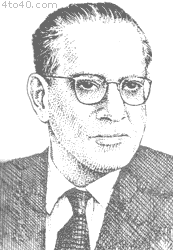 Tiruvenkata Rajendra Seshadri — In 1927 a young Indian started research under Robert Robinson, who later won the Noble prize, at Manchester University. Within a few a months he had his first test. He was asked to prepare in the laboratory some chemical compounds found in the rose and another flower.
Tiruvenkata Rajendra Seshadri — In 1927 a young Indian started research under Robert Robinson, who later won the Noble prize, at Manchester University. Within a few a months he had his first test. He was asked to prepare in the laboratory some chemical compounds found in the rose and another flower.
Seeing that he was not familiar with such work, Robinson advised him to take up an easier project. But the young man said that he would not give up a project without giving it a fair trial. And to the surprise of everyone in the laboratory, he completed the project after a few months of hard work. He had passed Robinson’s test and from that moment he never looked back.
The young man was Tiruvenkata Rajendra Seshadri, one of the founders of organic chemistry in India. Throughout his life he worked hard. A record number of 150 students did their Ph.D. under his guidance and he wrote 1,100 research papers. As a young man he first built the chemistry department of Andhra University, Waltair. Later he raised the chemistry department of Delhi University, to international level in the field of the chemistry of plant products. He was elected Fellow of the Royal Society in 1960.
Seshadri was born on February 3, 1900, in a poor but pious family at Kulittalai in Tamil Nadu. The religious atmosphere of places like Srirangam and Tiruchirapalli, where he spent his childhood, had an everlasting influence on him. And he never forgot that it was the Ramakrishna Mission that paid for his college education.
Under the guidance of good teachers at the Presidency College in Madras, his interest in chemistry bloomed. For his research there he was given several prizes and scholarships. In 1927 he went to Manchester University for higher studies. When he returned, he would have secured a lucrative job anywhere. But he chose what was then a lowly paid career, that of researcher and teacher.
What makes a flower beautiful? Its colors, of course. But what chemical compounds in the plant make its flower red or yellow? What chemical compounds make certain seeds and fruits astringent? What compounds does a teak tree produce which make its wood resistant to insects? What are the poisons and useful drugs found in certain plants? These are some of the questions that Seshadri investigated.
His research on hundreds of plants led to the discovery of many new chemical compounds. He studied their chemical structure and tried to produce them in the laboratory. He also tried to relate their chemical composition to their botanical classification.
Seshadri was considered an expert in the chemistry of lichens, a fungus-like growth. He not only discovered new compounds in them, but also studied how they damage sandal trees and archaeological monuments and ways to prevent such damage. Some of his findings are of great importance to agriculture and medicine.
Seshadri had great faith in God. He felt that science, philosophy and religion, if properly understood, were one and the same. He founded the Vedanta Samiti of Delhi University and used to take part in cultural and spiritual discussions. He died in 1975.
 Kids Portal For Parents India Kids Network
Kids Portal For Parents India Kids Network






